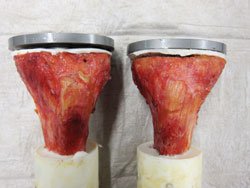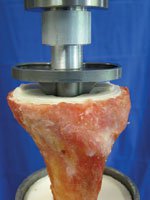Pulsed lavage yields greater fixation strength in total knee arthroplasty
 Ulf Schlegel |
Researchers comparing the effects of pulsed lavage against classic syringe lavage in total knee arthroplasty found that pulsed lavage reduces aseptic loosening of the tibial component and may also increase cement penetration, potentially improving fixation strength for the tibial tray and long-term survival of the implant.
“The study clearly indicates that cement penetration, and likewise cement-bone interface strength, can be improved significantly in cemented tibial components when pulsed lavage is implemented. As initial fixation strength is considered being a key to improved survival of the implant, pulsed lavage should be regarded as a mandatory preparation step in TKA [total knee arthroplasty],” Ulf Schlegel, MD, told Orthopedics Today.
Complications
In the study presented at the 12th EFORT Congress 2011, investigators analyzed six pairs of freshly frozen cadaveric, proximal tibia donor specimen with a mean age of 71.5 years for bone mineral density. Researchers used the PFC Sigma Knee System (DePuy Orthopaedics; Leeds, England). One side of the implant was injected with 1.8 L of saline fluid where pulsed lavage was used, while the other side used syringe lavage with the same amount of fluid. Following implantation of the tibial components, the investigators used postoperative CT scans to analyze a 3-D visualization of the cement mantle.
“The main complication remains the aseptic loosening of the tibial component,” Schlegel said in the presentation. “A lot of studies could show that pulsed lavage improves cement penetration into the cancellous bone. However, we do not have a real idea of whether this improves stability or not.”
|
|
|
|
|
The failure pattern following testing is shown. For the pulsed lavage construct (right), failure occurs at the implant-bone interface. For the syringe lavage construct (left), failure occurs at the cement-bone interface. |
Testing scenario with a pulsed lavage specimen shows the remaining cement mantle on the osseous surface. Images: Schlegel U |
|
Limitations
Investigators used a servohydraulic vertical material machine to test the strength of the tibial trays at a rate of 0.5 mm/sec and a frequency of 50 Hz until implant failure. Failure occurred at the implant-cement interface in the pulsed lavage group and at the bone-cement interface in the syringe lavage group, showing “how weak the resulting interface is when you use syringe lavage,” Schlegel said.
The team found that the pulsed lavage had more than double (1,275 N) the median pull-out force of syringe lavage under the same conditions. Cement penetration was also greater for pulsed lavage, which achieved 1.32 mm when compared with the syringe lavage group, which reached 0.79 mm. Improved mechanical stability of the tibial implant and increased bone cement interdigitation could be demonstrated in the current study, the authors wrote in the abstract.
Limitations of the study include the small sample size and the lack of standardization of the volume of cement per implant. Schlegel also suggested in his presentation that under a cementing technique involving the stem, overall pull-out forces would be higher, as a surface cementing technique was used in the study.
“This is more to be thought of [as] a model to get an idea how really stable the interface is. These [implants] are loaded under sheer compression and may incur sheer forces, but usually there is not any pull-out,” Schlegel said. – by Jeff Craven
Reference:
- Schlegel UJ, Siewe J, Delank KS, et al. Pulsed lavage improves fixation strength of cemented tibial components. Paper #222. Presented at the 12th EFORT Congress 2011. June 1-4. Copenhagen, Denmark.

- Ulf Schlegel, MD, can be reached at Department of Orthopaedic and Trauma Surgery, University of Heidelberg, Schlierbacher Landstr. 200a, 69118 Heidelberg, Germany; 49-6221-96-6302; email: ulf.schlegel@med.uni-heidelberg.de.
- Disclosure: Schlegel received funds from DePuy Orthopaedics for this study.
 A. Seth Greenwald |
This report provides a reminder of the importance of optimizing the tibial cement-bone interface in primary, total knee arthroplasty (TKA) procedures. The employment of pulsed lavage as an assist in removing tissue, blood and fat to realize the benefit of a dry trabecular bone interface dates back over 30 years in the orthopedic literature and has contributed to the longevity of contemporary knee reports. It is standard practice in the United States and is again justified by this paper.
In a paired cadaver study, the authors report that the interfacial strength more than doubled when compared to syringe irrigation only. The result emphasizes the importance of this step in the cementing process, which is also influenced by the manner of cement mixing, cement application and operating room temperature. The methodology embraces the sole application of cement to the trabecular bone tibial surface, however, it is not an uncommon practice to also apply cement to the distal surface of the tibial tray. The latter provides a durable homogenous mass so long as the cement is applied early in its dough stage. However, with increasing dough time, the potential for creation of a seam between the two cement masses can be realized, which weakens the construct, and is a further consideration in the cementing process. The utilization of topical hemostatic agents may also assist the drying of the trabecular bone interface, an important consideration when a tourniquet is not employed. The sine qua non of the cementing process is to ensure that cement application occurs on a dry, clean trabecular field.
— A. Seth Greenwald, DPhil (Oxon)
Orthopedics Today Editorial Board member
Orthopaedic
Research Laboratories
Cleveland
Disclosure: Greenwald has no
relevant financial disclosures.
The authors of this useful piece of work have rightly drawn attention to the importance of thorough cleaning of cancellous bone surfaces in cemented joint replacement. It has long been understood by expert centers skilled in the use of cemented arthroplasties that proper cleaning of the bone surfaces prior to cementation leads to more accurate and more secure cement bone interfaces.
This well-conducted and convincing study is yet another in a long line of published work which emphasizes the importance of proper cleansing of bone surfaces prior to cementation. This is, however, only one part of the techniques necessary to ensure success of cemented implants. Accurate bone cuts and pressurized cement injection are equally important in ensuring the best possible implant fixation, which are the keys to long-term survival of the implant. These techniques should be more widely practiced and taught by the principal orthopaedic units, implant manufacturers and perhaps also recommended by NICE [National Institute for Clinical Excellence].
— Christopher E. Ackroyd, MA, MB, Bchir,
FRCS
Orthopaedics Today Europe Editorial Board member
Avon
Orthopaedic Centre
Bristol, United Kingdom
Disclosure: Ackroyd has
no relevant financial disclosures.
Schlegel et al have demonstrated the use of pulse lavage prior to cementing results in a superior fixation of the tibial component. Pull-out forces were doubled to 1,275 N compared to only 568 N in the syringe lavage group. Cement penetration was likewise increased from 0.79 mm to 1.32 mm. Pulsatile lavage is advised when cementing a tibial component.
— Peter Verdonk, MD, PhD
Department of
Orthopaedic Surgery
Ghent University Hospital
Ghent,
Belgium
Disclosure: Verdonk has no relevant financial
disclosures.



